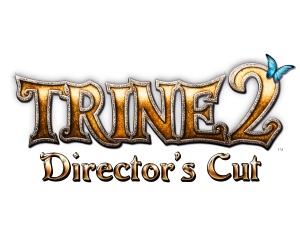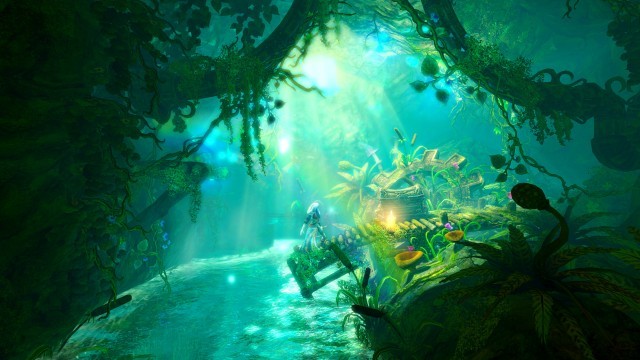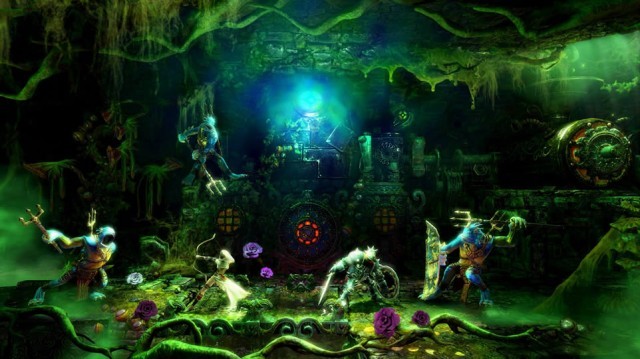Trine 2: Director’s Cut Review
 Game: Trine 2: Director’s Cut
Game: Trine 2: Director’s Cut
Developer: Frozenbyte
Publisher: Frozenbyte
Available on: Wii U only
Anyone who subscribes to that old sour chestnut that video games are not art has never played Trine 2. One of the most beautiful-looking and under-appreciated games of this year (the XBLA and PC version was actually released in the last week of 2011), Frozenbyte’s adventure fuses together elements of platforming, puzzle-solving, RPG-like progression and exploration to deliver a fantastic final product that’s just a little bit different to everything else.
Before we get to the nitty-gritty, it’s worth saying that the Wii U version loses none of the colour and vibrancy of other editions, the fairytale splendour remaining intact throughout. The enchanted forest setting is as alluring as anything you’d expect to see in a Pixar movie, populated by towering, overgrown plants and cottage-sized wildlife. The world is a riot of colour, like someone smashed a rainbow into tiny pieces and covered Trine 2 in glittering, multi-hued confetti, and it’s all brushed over with a dreamlike haze that further enhances the sense of wonder.

Trine 2 sees the three heroes from the first game reunited when a fresh calamity befalls their kingdom. Amadeus the Wizard (who’d rather be at home with his wife and kids), Pontius the Knight (who’d rather be saving distressed damsels) and Zoya the Thief (who’d rather just be stealing stuff) are all called upon by the titular Trine, a mysterious artefact that defends the world. Strange things are afoot in the enchanted forest, as animals grow to colossal heights and goblins stalk the shadows. It’s all because of two witches, sisters torn apart by petty rivalry whose magic is corrupting the land, causing the forest to grow wild and encroach on goblin territory, which in turn is getting the green-skinned brutes all riled up.
The characters, as much as the world design, are part of what make Trine 2 so likeable, not just because of the script (which has a Pratchett-esque, Simon the Sorcerer kind of comedy to it), but because of how their differing skills come into play to solve puzzles, overcome enemies and explore the world. Each has a set of unique skills that complement the other two, creating a wonderful dynamic wherein none could complete the game alone, but together there is nothing that they can’t tackle. It’s handy then, that the Trine’s magic combines them into one gestalt entity and allows you to switch between them at will.
Amadeus can levitate objects and enemies, or create boxes out of thin air; Pontius can block attacks with his shield, despatch enemies with his sword or smash down walls with his hammer, and Zoya can fire arrows, become temporarily invisible and use a grappling hook to reach high ledges or cross wider gaps. So, for example, say you come across a huge abyss with a stone wall on the opposite side and a huge spiked ball on a chain above it. You could use Amadeus to set the chain swinging by grabbing it with his magic hand, pulling it right up and letting it go, then switch to Zoya and use her grapple to hook to it as it swings, before jumping off and selecting Pontius to smash down the barrier. That’s a simple example (and in fact Trine 2’s conundrums are often way more challenging) but even that is only one way of solving the puzzle. Often, playful experimentation yields interesting results.

When a character is killed you’ll be able to carry on by switching to one of the other two, and this is the only place where Trine 2 very nearly becomes a little imbalanced. Losing any character could potentially make a simple puzzle insurmountable, so Frozenbyte have included numerous checkpoints that bring everyone back to life. Often these are placed before either a puzzle, boss fight or large group of enemies, and make progression through the actual story (puzzles aside) incredibly easy. It’s a minor grumble, as the game is way more focused on puzzles than combat, but it does remove a lot of the tension from fighting when you know you can retreat a few yards and resurrect your allies whenever you like.
Thankfully, there are many reasons to wander off the path such as collectibles and hidden vials, 50 of which, when collected, will allow you to level up. Each level climbed affords you a skill point to spend across all three characters, unlocking new abilities or upgrading old ones. You can even re-spec at the cost of one point whenever you like, allowing you to modify your tactics on the fly.
But all that aside, this is a port of an existing game onto new technology, so the big question is: How does the Gamepad affect things? To be honest, it’s slightly hit and miss; though mostly hit.
For example, the touch screen controls make drawing a square to conjure one of Amadeus’ boxes much quicker and easier, and levitating or moving objects with precision is a doddle. Likewise, aiming Zoya’s bow is easy when you’ve got time to stand still and angle it right, but in combat it’s simpler and quicker with the face buttons. Pontius, on the other hand, is made for button control, and the only thing more intuitive with touch is switching between sword-and-shield and hammer. While you can choose to turn off the telly and play the whole game handheld-style, I often found that the colours are so rich and the highly-detailed environments so busy that it’s hard to see exactly what’s happening on the smaller GamePad screen.

Local co-op is neither helped nor hindered by the GamePad itself, but by the fact that a second or third player will have to use a WiiMote and Nunchuck to play. It’s not a major annoyance, but it’s a hell of a lot more cumbersome and makes quick actions and character changes tricky. Online co-op is definitely the way to go, but communication is key, otherwise you’ll end up standing around holding a gate open while everyone else gawps at the scenery. In co-op, Trine 2 becomes all about teamwork, especially as you can never have two of the same character active. You can swap characters, but both parties must consent to it, so it’s best to simply pick a role you’re good at and play it well.
You could argue that the game is intended to be played in co-op, as the combination of abilities really shines here where, for example, Pontius can give another character a boost on his shield, or Amadeus can conjure a box in mid-air for someone to vault from. Battles switch from the frantic melee-only affairs that they often are in single player and become more about having fun with your enemies, with Amadeus dropping magic boxes on their heads to soften them up while Pontius stands in front to soak up the damage and Zoya peppers everything with arrows. Played in 3-player co-op with friends who know what they’re doing, Trine 2 is the very best of its kind.
The Wii U port is slightly longer than the original version, as it comes with the downloadable Goblin Menace expansion which continues the story that little bit further. It doesn’t add anything much beyond the six levels themselves, though the handful of new skills are more than welcome. It shows that, with DLC, Frozenbyte had time to think on the puzzles a while, as there a few head-scratchers included, but nothing to trouble veterans. A new multiplayer mode was announced entitled Magic Mayhem, but sadly didn’t make the final game; although the word on the street is that it’ll be available as DLC at a later date.
VERDICT: Trine 2 is an excellent choice for a Wii U launch title, but that’s more due to the game itself being great rather than the GamePad integration. It’s a great puzzle-platformer in its own right, and the aesthetics are absolutely beautiful; it’s just a shame some of the splendour and ease of control is lost on the smaller touch-screen. For a downloadable title, you’re also getting a heap of content: Not only including the main game and the aforementioned DLC, but also the “hardcore” mode that offers a much tougher challenge, greater distance between checkpoints and harder enemies.
At a whopping 1943 MB, the download will trouble those who didn’t buy a Premium Pack, but the file-size is expected and excused due to the quality and amount of content. If you’re one of those who argues that games are not art, or who thinks the Wii U can’t match the HD grandeur of the 360 or PS3, I implore you to download Trine 2 immediately and have your mind changed on both counts. It might not be perfect, but it’s absolutely worthy of a spot in the Wii U’s launch line-up.





